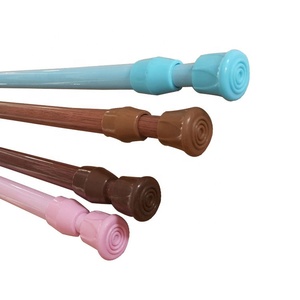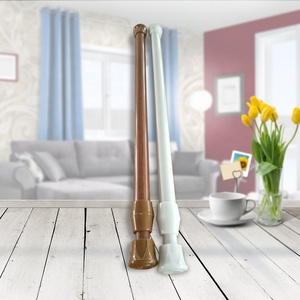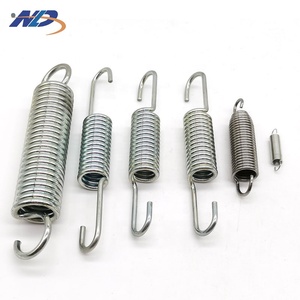(190 products available)
















































































































































































































 Ready to Ship
Ready to Ship











A spring-loaded tension rod is a type of rod commonly used in mounting curtains, shower curtains, and other partitions. It is a flexible tool used in many ways. There are several types of spring-loaded tension rods available in the market. Some of them include:
Regular tension rods
Regular tension rods are the most widely used. They are placed in the middle of two walls to hold curtains, drapes, or other decorative materials. They use springs to create pressure between the two walls. The spring is used to hold the rod tightly between the two ends of the walls. These rods are adjustable and easy to install. They have a simple design and are primarily used to hang curtains. They come in different sizes and can be adjusted to fit the desired width.
Heavy-duty tension rods
Heavy-duty tension rods are designed to hold weighty curtains or items. They are made of strong material and have a thick diameter. They can hold heavy curtains, drapes, or even shower curtains without any risk of falling off. They are mostly used in commercial places like offices, schools, or industries where heavy curtains are used. They are also used in houses where large, heavy curtains are required.
Spring-loaded curtain rods
Spring-loaded curtain rods are used to hang curtains and are placed on windows. They are mostly used in small places where permanent installation of rods is not needed. They come in different colors and sizes to match the home decor.
Expandable tension rods
Expandable tension rods are flexible and can be expanded or contracted to fit into a particular space. They are mostly used in small places where the size of the item may change.
Adjustable tension rods
Adjustable tension rods are designed with twist mechanisms at their ends. They can be adjusted to fit into an open space. They are mostly used in small places where the size of the rod may change.
Telescoping tension rods
Telescoping tension rods are designed to fit into small places. They can be expanded and contracted like a telescope. They are mostly used in small places where the size of the rod may change.
Clothes tension rods
Clothes tension rods are used to hang clothes in small spaces like doors or small cabinets. They are mostly used in homes and offices to hang coats and jackets.
Kitchen tension rods
Kitchen tension rods are tension rods used in kitchens to hang kitchen towels.
Bathroom tension rods
Bathroom tension rods are used to hold shower curtains in the bathrooms to prevent water from going outside the bathing area. They are mostly found in all types of bathrooms.
Decorative tension rods
Decorative tension rods are small tension rods used in cabinets or on top of dressing tables to hang or organize different types of accessories such as jewelry. They come in different colors and sizes to match the decor.
The design of spring-loaded tension rods involves creating a product that is sleek and minimalist. It should be able to fit into any space and be used for multiple purposes. These evergreen elements of design can be applied to any type of spring-loaded tension rod. They ensure that the product is not only functional but also adds aesthetic value to the space in which it is used.
Spring-loaded tension rods are incredibly versatile and practical. They can be used in multiple situations, both at home and in other places.
There are several factors that one needs to consider when choosing the right spring-loaded tension rod. These include:
Purpose:
One should always remember the purpose of the tension rod before purchasing it. Is it for hanging curtains, holding back shower curtains, or perhaps organizing a closet? Different purposes may require different types of rods with specific features, such as weight capacity or length adjustment range.
Material:
Spring-loaded tension rods are usually made from various materials, including metal, plastic, or a combination of both. Metal rods tend to be more durable and can support heavier loads, while plastic rods are lighter and rust-resistant, making them suitable for damp areas like bathrooms.
Length and adjustment range:
The beauty of spring-loaded tension rods is that they can be adjusted to fit different spaces. When purchasing one, check its minimum and maximum lengths to see if it will fit in the intended area. Some tension rods have a wider adjustment range, making them more versatile for various spaces.
Weight capacity:
Each tension rod has its weight limit, which one must not overlook when purchasing it. If one plans on hanging heavy curtains or holding large items with the rod, it is wise to choose one with a higher weight capacity to avoid accidents or damage to the walls caused by using an inappropriate object.
Ease of installation:
One should look for a tension rod that can be installed easily without the need for special tools or skills. Spring-loaded tension rods are generally user-friendly and can be set up within minutes. Additionally, some rods come with clear instructions and all the necessary hardware, making the installation process a breeze.
Durability:
For tension rods to be long-lasting, they should be made from durable materials that can withstand regular use without showing signs of wear and tear. Metal rods are usually more robust than their plastic counterparts; however, good-quality plastic can also be a durable option, especially in areas prone to rust or corrosion.
Adjustability:
One of the key features of spring-loaded tension rods is their adjustability. These rods can be easily expanded or compressed to fit within the desired space, making them perfect for temporary or removable installations.
Wall protection:
Look for tension rods that have protective features, such as rubber or plastic caps, which help prevent damage to the walls. These caps provide a cushioning effect and ensure a secure grip without leaving marks or indentations on the walls.
Aesthetics:
If the tension rod is visible and contributes to the room's decor, one might want to choose one that matches the aesthetic of the space. Tension rods come in various finishes, including chrome, bronze, and white, allowing them to blend seamlessly with the surrounding decor.
Q1: How can one install or remove a spring-loaded tension rod easily?
A1: One can easily install or remove a spring-loaded tension rod by simply expanding or contracting it. To install, expand the rod until it fits snugly between the two surfaces and release it. To remove, compress it and release it.
Q2: How does one adjust the length of a spring-loaded tension rod?
A2: To adjust the length of such a rod, twist its two sections in opposite directions to lock/unlock the length adjustment mechanism.
Q3: Is a spring-loaded tension rod suitable for holding curtains only?
A3: No, these are versatile tools used to hold curtains, shower rods, shelves, and a variety of other items.
Q4: How does one maintain a spring-loaded tension rod?
A4: Regular cleaning and lubrication of the springs and threads are essential for the maintenance of such rods.
Q5: What are some common applications of spring-loaded tension rods?
A5: These rods are commonly used to hang curtains, shower curtains, and organize tools and other household items.
The web search volume for the keyword "spring loaded tension rod" has shown notable fluctuations over the past year, with an average monthly web search volume of 110. Over the last 12 months, there has been a significant three-month and one-year decline of 55%. Detailed monthly data reveals a pattern of highs and lows, with July 2024 recording the peak web search volume at 170 and November 2024 hitting the lowest at 50 web searches.
Analyzing the trend, the web search volume for "spring loaded tension rod" typically stabilizes around 110 web searches per month, except for some months that show deviation. For instance, February 2024 and June 2024 both saw a reduction to 90 web searches, while July and August showed an increase, indicating a possible seasonal interest in these products. The sharp decrease in November could suggest a seasonal dip or a specific market condition affecting consumer interest in this category of electrical equipment and supplies.
The detailed monthly breakdown underscores the volatility in consumer interest, which could be influenced by various factors including market saturation, product innovations, or shifts in consumer preferences. Despite these fluctuations, the keyword maintains a steady base level of web searches, suggesting ongoing relevance and necessity in the market, albeit with variable demand throughout the year.